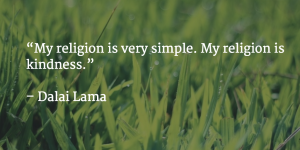1-Sentence-Summary: The Art Of Happiness is the result of a psychiatrist interviewing the Dalai Lama on how he personally achieved inner peace, calmness, and happiness.
Read in: 3 minutes
Favorite quote from the author:

Audio Summary
Listen to the audio of this summary with a free reading.fm account:
Yesterday morning, at 7:00 AM, my uncle died. He went to the toilet, back to bed, fell asleep, and just never woke up again. He was 52 years old. Last year he had lost 60 lbs, and was in the best shape of his life.
Seneca said “Life is long, if you know how to use it.” But sometimes life truly is short. I think he used his life well. Nevertheless, if you’ve ever faced such pain in your own life, you know that you instantly start to search meaning in it.
My search led me to The Art Of Happiness, a book based on psychiatrist Howard C. Cutler interviewing the 14th Dalai Lama about happiness.
Here are the 3 things I learned:
- You don’t have to be religious, to be spiritual.
- The only constant thing is change.
- Know your limits.
Let’s examine them a bit further.
Lesson 1: You don’t have to be religious, to be spiritual.
My uncle’s body will be cremated. Do you know how long the Wikipedia article for cremation is? It’s a widely spread, religious practice, used in many cultures, Western or Eastern.
I don’t know much about it. No one in my family is very religious, some of us are even atheists. But that doesn’t mean we can’t be spiritual.
The Dalai Lama says it doesn’t matter which religion you belong to, or whether you belong to any, for that matter.
He believes in basic spirituality, being compassionate, a good person, and caring for one another.
I spent a lot of time thinking yesterday. I took a long walk with my roommate, and we talked about life. My Mum called, and I spoke to my cousin as well.
We each have our own way of dealing with suffering, and none of them are right or wrong.
To me, being spiritual means seeing the bigger picture, understanding that there is a meaning behind everything, and learning from both good and bad events.
Only then can I take what I learned and use it for both my own and the greater good.
Ask yourself: What does being spiritual mean to you?
And then don’t let anyone tell you you’re wrong.
Lesson 2: The only constant thing is change.
When asked about suffering, the Dalai Lama shares a big mistake we “Westerners” make: thinking it’s unnatural.
Suffering is a part of life, he says, but by rejecting that we make ourselves into victims and start assigning blame, when there really is none to be assigned.
The only constant thing is change.
As contradictory as it may sound, it means we have to learn to let go.
Resistance to change leads to suffering. As a matter of fact, it is the root cause of suffering.
Once you accept the change, you can openly address it, find the meaning in it, and learn from it.
You can bitch and moan about slamming your car door and hurting your hand, yell at the cashier for being too slow, or cry for hours after a loved one dies.
But the second you accept the change, that’s when progress happens. It’s when you calm down and turn the situation around. And that’s the path to happiness.
Lesson 3: Know your limits.
There are a lot of different approaches to building confidence, most of them based on challenging yourself (including mine).
The Dalai Lama has a great alternative point of view here. He says to know your limits.
Be honest with yourself and others about what you can and cannot do. If you’re okay with not knowing everything, then you can openly admit it, and won’t feel like a fraud.
So rather than building confidence from the outside, build confidence from the inside, by allowing yourself to be honest.
And if you don’t understand something, try this. Say “I don’t understand.” People will explain again.
Being okay with your limits, however, means knowing what they are in advance, and that requires self-awareness.
So do an audit on yourself. What are you really good at? What do you suck at?
Go all in on those strengths, and be honest with yourself and the world around you.
The Art Of Happiness Review
It takes a while to process when a loved one dies. I know I haven’t fully grasped it yet. But I’m not going to fight it.
Instead, I’m taking 2 major lessons from my uncle’s premature death:
- Stop doing shit you hate. There is no reason to do work you don’t like. None.
- Spend time with family and friends, because you never know how much you’re gonna get.
I don’t think it’s a coincidence that he stopped by our house the day before he died and talked with my Mum about not doing things we don’t like.
If anything, it’s a confirmation for me to keep writing, coaching, freelancing, and doing work I enjoy, until everything comes together in the big picture.
I’m really grateful for this lesson from The Art Of Happiness, and for the Dalai Lama’s wisdom. But I will still miss my uncle. R.I.P.
Who would I recommend The Art Of Happiness summary to?
The 12 year old, who’s being teased about being religious in school, the 37 year old big city mum, who feels she needs a break from Western society, and anyone who just lost a loved one.
Last Updated on July 27, 2022